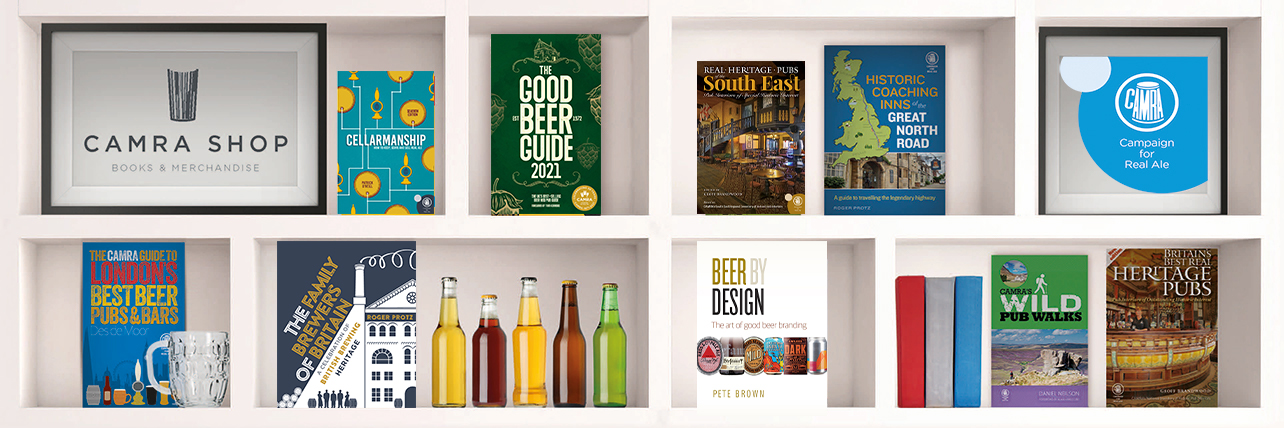Learn & Discover
Learn & Discover
Cider Lexicon – Part.2
Unlike beer, wine and spirits, cider lacks a lexicon – a set of language and descriptors specifically associated with cider (although often shared with other drinks). A lexicon helps the trade, and ultimately the consumer, to understand the full range of different flavours, processes, cultures and styles that exist within the world of cider. Building on his book Modern British Cider, Gabe Cook develops a shared a language that can form the basis for the description and understanding of cider within CAMRA, the trade and with consumers. A technical and narrative language to give the full story of what cider is, how it is made, how it is presented to the consumer and ultimately how it is consumed.
Gabe Cook
Gabe is leading the charge for a cider revolution. AKA ‘the Ciderologist‘ Gabe is an international consultant, writer, broadcaster, and educator on all matters cider.
Beer dispense containers
Sub title goes here – delete if N/A
Lorem ipsum dolor sit amet, consectetur adipiscing elit. Nullam lobortis vel sapien nec faucibus. Morbi consectetur pulvinar lectus, vitae sodales tellus. Sed sagittis aliquam convallis. Duis mollis libero eu massa luctus, id euismod urna fringilla. Aenean condimentum accumsan leo nec eleifend. Maecenas ullamcorper est non justo pulvinar accumsan.
Emma Inch
A CAMRA member since 1997, John is volunteer with a keen interest in the technicalities of beer dispense, a GBBF bar manager, editor of Manchester’s Beer Buzz magazine and sits on CAMRA’s Technical Advisory Group.

Styles
The last, logical step in the creation of a full lexicon for cider is the creation of named styles, with certain signature aroma, taste and mouthfeel characteristics. The following styles are not definitive or rigid. I call this the beginning of the conversation – not the end.
There will be much disagreeance as to the merit or necessity for creating styles, but I do so with the endeavour of getting the drinks trade and the consumer, more aware, knowledgeable and passionate about how different ciders are made and how they taste.
Western Counties (WestCo)
A style with its roots in the Western and Southern Western parts of England and over the border into Monmouthshire in Wales. Made using classic, tannin-rich, bittersweet cider apple varieties to provide bold, structured and intense aromas, flavours and mouthfeel. Varieties that bring some acidity (bittersharps and sharps) and fruitiness (sweets) are often classically used to provide softness and balance.
Orchards containing these varieties are now being planted across Britain, indeed the globe, to replicate the overarching flavour profile of this style but with some significant variations occurring owing to the variations in the specific terroir.
The majority of exponents of WestCo cider are made as a blend of two or more varieties, pre and/or post fermentation. However, today, there are many exponents of single varietal WestCo ciders, which display the idiosyncratic character of the apple, which can, on occasion, be as equally acidic as tannic.
Characteristics:
Aroma: dominated, to a greater or lesser extent, by the presence of phenolics bringing barnyard, spicy, medicinal or earthy; fresh, fruity and estery aromas may be present also.
Flavour: an interplay of tannic characteristics (earthy, spicy, wood, bitter, savoury), fruitiness (ranging from fresh to basked) and an acidity ranging from non-existent to intense.
Mouthfeel: tending towards increasing levels of complexity and chewiness with some degree of astringency and a generally longer finish compared to other styles of cider. Dryness perception is upweighted because of the mouth drying sensations.


Styles
The last, logical step in the creation of a full lexicon for cider is the creation of named styles, with certain signature aroma, taste and mouthfeel characteristics. The following styles are not definitive or rigid. I call this the beginning of the conversation – not the end.
There will be much disagreeance as to the merit or necessity for creating styles, but I do so with the endeavour of getting the drinks trade and the consumer, more aware, knowledgeable and passionate about how different ciders are made and how they taste.

Western Counties (WestCo)
A style with its roots in the Western and Southern Western parts of England and over the border into Monmouthshire in Wales. Made using classic, tannin-rich, bittersweet cider apple varieties to provide bold, structured and intense aromas, flavours and mouthfeel. Varieties that bring some acidity (bittersharps and sharps) and fruitiness (sweets) are often classically used to provide softness and balance.
Orchards containing these varieties are now being planted across Britain, indeed the globe, to replicate the overarching flavour profile of this style but with some significant variations occurring owing to the variations in the specific terroir.
The majority of exponents of WestCo cider are made as a blend of two or more varieties, pre and/or post fermentation. However, today, there are many exponents of single varietal WestCo ciders, which display the idiosyncratic character of the apple, which can, on occasion, be as equally acidic as tannic.
Characteristics:
Aroma: dominated, to a greater or lesser extent, by the presence of phenolics bringing barnyard, spicy, medicinal or earthy; fresh, fruity and estery aromas may be present also.
Flavour: an interplay of tannic characteristics (earthy, spicy, wood, bitter, savoury), fruitiness (ranging from fresh to basked) and an acidity ranging from non-existent to intense.
Mouthfeel: tending towards increasing levels of complexity and chewiness with some degree of astringency and a generally longer finish compared to other styles of cider. Dryness perception is upweighted because of the mouth drying sensations.

I recognise (and welcome!) that there will be conjecture at my use of the term Western Counties, a portmanteau of ‘West Country’ and ‘Eastern Counties’. I have chosen this term over ‘West Country’ because, although not formally delineated as a region, the ‘West Country’ is generally considered to not include large chunks of Gloucestershire, Worcestershire and particularly, Herefordshire and Monmouthshire, which all have equally as strong cultures of making cider from tannic apples as that characterised by Devon and Somerset.
By looking at a map, one can discover that Hereford actually sits on a longitude further West than Bath, Bristol, Yeovil and Shepton Mallet, giving extra validity to emphasising the Western nature of the ciders made in these Counties. I also believe that the term ‘West Country’, for many consumers, will still harbour connotations of ‘roughness’ or ‘scrumpy’.
The primary driving factor here is to provide the trade and the consumer with an easily known and understood reference for ‘a cider dominated by phenolic aromas and a tannic taste profile’. That’s not exactly the snappiest of titles, so Western Counties it is. I will also be advocating the shorthand version ‘WestCo’, and similarly ‘EastCo’ for Eastern Counties style (see next). Now that is really going to get some people’s goat and I’m fine with that. Again, the purpose is it makes a broader style of cider known as being appreciably different from other styles of cider.
I must stress in the highest possible terms, that if a cider maker wishes to use West Country rather than Western Counties, then I’m fine with that. The same goes for emphasising the individual County as well as any other descriptor, such as traditional, real or craft. The more we can give the trade and consumers to work beyond dry, medium and sweet feels like a win to me!

I recognise (and welcome!) that there will be conjecture at my use of the term Western Counties, a portmanteau of ‘West Country’ and ‘Eastern Counties’. I have chosen this term over ‘West Country’ because, although not formally delineated as a region, the ‘West Country’ is generally considered to not include large chunks of Gloucestershire, Worcestershire and particularly, Herefordshire and Monmouthshire, which all have equally as strong cultures of making cider from tannic apples as that characterised by Devon and Somerset.
By looking at a map, one can discover that Hereford actually sits on a longitude further West than Bath, Bristol, Yeovil and Shepton Mallet, giving extra validity to emphasising the Western nature of the ciders made in these Counties. I also believe that the term ‘West Country’, for many consumers, will still harbour connotations of ‘roughness’ or ‘scrumpy’.
The primary driving factor here is to provide the trade and the consumer with an easily known and understood reference for ‘a cider dominated by phenolic aromas and a tannic taste profile’. That’s not exactly the snappiest of titles, so Western Counties it is. I will also be advocating the shorthand version ‘WestCo’, and similarly ‘EastCo’ for Eastern Counties style (see next). Now that is really going to get some people’s goat and I’m fine with that. Again, the purpose is it makes a broader style of cider known as being appreciably different from other styles of cider.
I must stress in the highest possible terms, that if a cider maker wishes to use West Country rather than Western Counties, then I’m fine with that. The same goes for emphasising the individual County as well as any other descriptor, such as traditional, real or craft. The more we can give the trade and consumers to work beyond dry, medium and sweet feels like a win to me!
Keeved
A style with a record of being produced in Britain historically, but most strongly associated with the classic cider making culture of the Brittany and Normandy regions of Norther France. Made using classic, tannin-rich, bittersweet cider apple varieties to provide bold, structured and intense aromas, flavours and mouthfeel. Varieties that bring some acidity (bittersharps and sharps) and fruitiness (sweets) are often classically used to provide softness and balance.
The primary, defining characteristic of these ciders, beyond their phenolic and tannic characters is undergoing a particular process prior to fermentation, known as keeving. This process involves the precipitation of pectin out of the juice, binding onto yeast and nutrients before rising to the surface. The subsequent yeast and nutrient deficient juice is then transferred to another vessel for fermentation.
Fermentation tends to be slow and incomplete, normally leading to a lower alcohol content and retention of residual sweetness. These ciders are often presented in a 750ml bottle, with a degree of natural carbonation.
Characteristics:
Aroma: phenolic characters dominate, often with spicy, earthy and barnyard dominating; also, the presence of ‘juicy’ fruit aromas.
Flavour: rich, roasted, spicy fruitiness interplays with soft bitterness and earthiness, with generally no/low level of acidity.
Mouthfeel: tending towards increasing levels of complexity and chewiness with some degree of astringency and a generally longer finish than other styles of cider. Dryness perception is counteracted by intense, smooth juiciness.

Cider lexicon Pt.1
Check out part 1 of Gabe Cook’s a Cider lexicon
Knowing Cider & Perry Styles
Watch Pomellier Jane Peyton’s video guide to cider and perry styles





